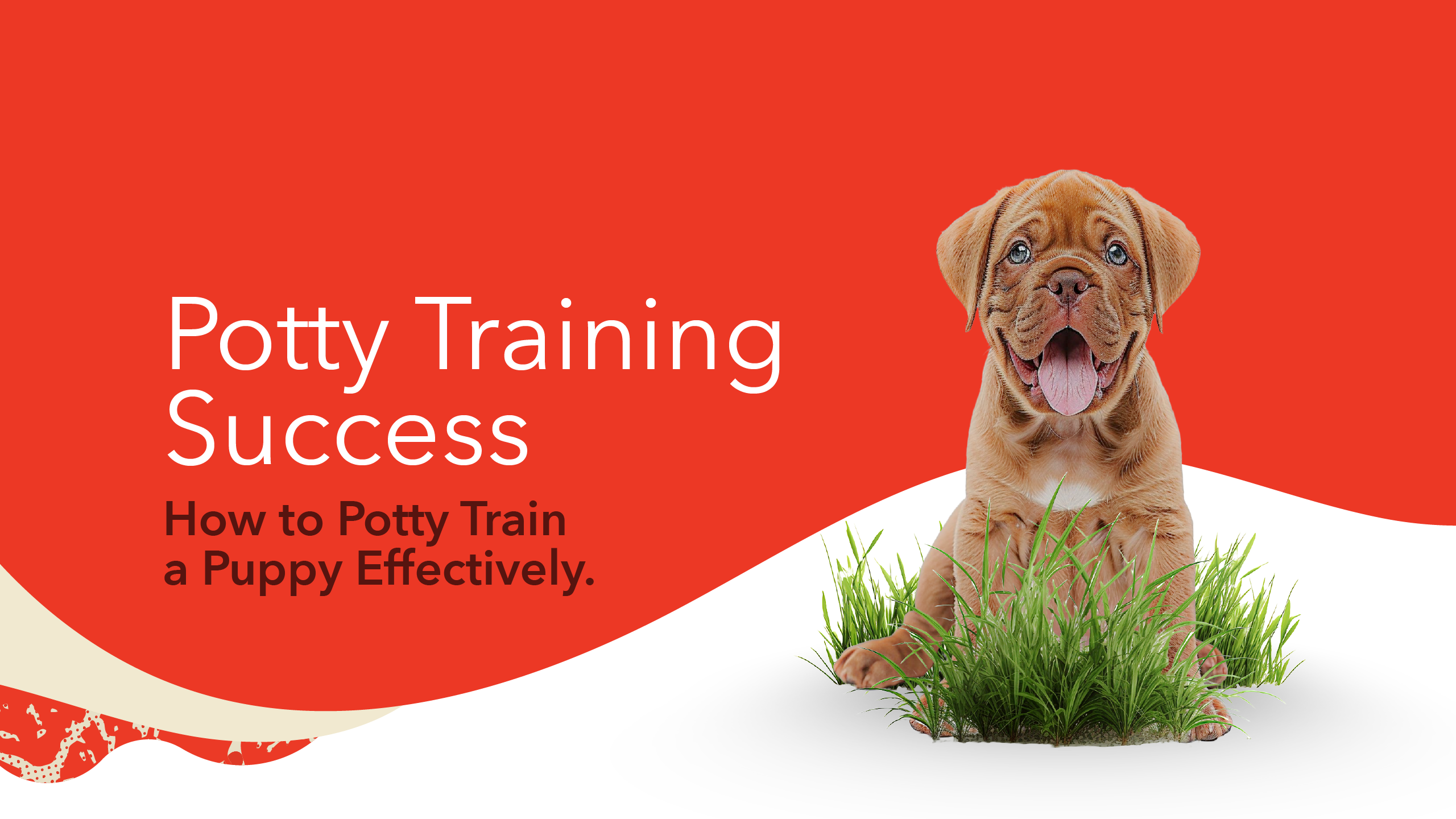
Potty Training Success: How to Potty Train a Puppy Effectively
Congratulations on the new bundle of fur you’ve just brought home or are preparing to bring home! Naturally, one of the first things you need to learn is how to potty train a puppy. With a proper potty schedule, plenty of praise when they “go” where they’re supposed to, and lots of patience, your puppy should start to understand potty training basics in as little as a week or two (although most puppies aren’t fully potty trained until they’re 9 months or older).
Keep reading for all the tips and tricks you need to successfully potty train your puppy.
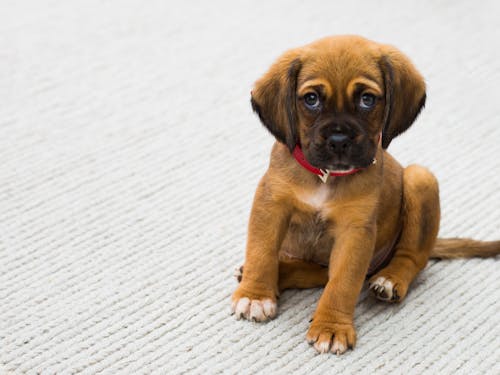
How Long Does it Take to Potty Train a Puppy?
While most puppies can learn potty training basics within about a week, they typically aren’t fully potty trained until they’re closer to 9 months or a year old. That’s because puppies have small bladders, so they’re more likely to have accidents when left alone for long time periods.
On average, puppies can only control their bladders for one hour per month of age. Therefore, if you have a two-month-old puppy, they need to be taken out at least every two hours during the day to prevent accidents. If you work away from home and need to leave your puppy alone for 9 hours or longer, you should plan on having friends, neighbors, or pet sitters take your puppy out for potty breaks until they’re at least 9 months old since they won’t be able to hold their bladder all day.
Establishing a Routine
The key to successful potty training is sticking to a routine. If a two-month-old puppy can only hold their bladder for up to two hours, you should take them outside every hour to give them a chance to do their business before they decide to relieve their bladder indoors. You should also take your puppy outside after meals, drinking, playing, and waking up, since all those things can trigger a puppy’s need to use the bathroom.
Taking Your Puppy Outside
Always take your puppy on a leash to the exact same spot to potty. Eventually, they can learn to “go” other places, but they should start by learning one place where you want them to do their business to limit their urge to explore. Additionally, once they pee and poop there, those smells will linger and serve as a reminder of what they’re supposed to be doing out there.
You can use a specific word every time your puppy pees or poops if you want to eventually teach them to do their business on command.
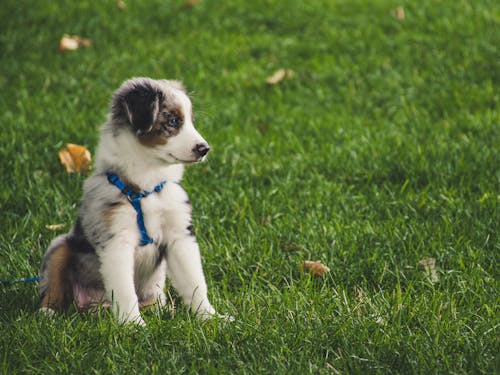
Rewards and Praise
Every time your puppy pees or poops outside in the designated area, you should immediately reward them with praise, treats, a longer walk, or playtime. This will help reinforce the idea that they did the right thing and will encourage them to keep doing their business in that spot.
Feeding and Water Schedules
Puppies’ stomachs are just as tiny as their bladders, so they should be fed three to four times a day. Keep in mind that what goes in must come out, so always plan a trip outside right after mealtime. (It takes some time to digest their meals, of course, but having a full stomach often triggers a puppy to want to relieve their bowels.)
Remove your puppy’s water bowl about two and a half hours before bedtime to lower the number of nighttime bathroom trips they’ll need. Puppies can often sleep for about 7 hours at night without needing to go out, but your puppy may still wake up and need out sooner than that. If so, take them right out to do their business and then go right back to bed without any extra stops or playtime so you can both fall quickly back to sleep.
Active Supervision
For best results when potty training, somebody should actively be watching your puppy any time they aren’t confined to a crate or a small tile-floored room where it’s easy to clean up accidents. That includes when they’re out in the yard; you should keep them on a leash and wait to give them more freedom until after they’re potty trained.
Tethering your puppy to you with a short leash is a great way to ensure you can always keep an eye on them and look for signs that they may need to go out, like restlessness, circling, squatting, barking, or scratching at the door.
Remember that the goal is to take your puppy outside before they have a chance to have an accident inside.
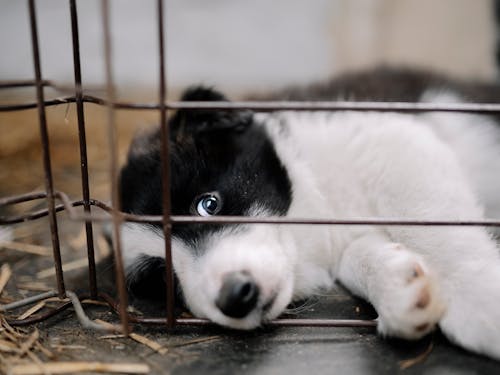
Confinement Strategies
Potty training and crate training go together like beans and rice, peanut butter and jelly, and Cinnabon plus literally any fast food restaurant. Even if you don’t plan to keep your puppy in a crate when they’re grown, they’re likely to encounter crates or kennels at the vet, groomer, boarding facility, or elsewhere, so it’s best to get your puppy used to a crate when they’re young.
Keep in mind that dogs are den animals. Your puppy will likely seek out a small dark area whether you provide one or not. Giving them a crate to make their own safe space is one of the best things you can do to raise a happy, healthy, well-adjusted puppy. Additionally, your puppy will naturally want to keep their safe space clean, helping reinforce your potty training.
If you choose not to crate train your puppy, you should confine them to a small room or area like an ex-pen to limit the area where they might have accidents while unsupervised.
Ideally, the crate or other containment area should be just big enough for your puppy to stand up, lie down, and turn around, but not so big that they can pee or poop in one corner and sleep comfortably in another corner. If you have a large-breed puppy, look for a crate that comes with a divider so the space can “grow” with your puppy.
When letting your puppy out of the crate or containment area, always take them directly outside first thing to give them a chance to go potty.
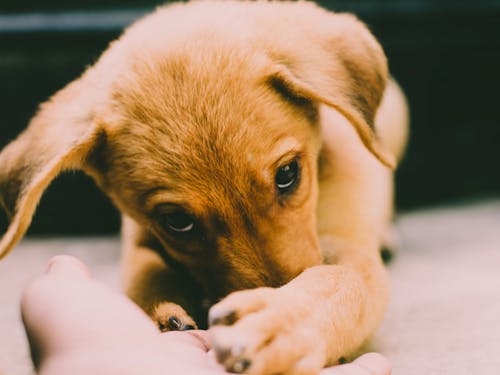
Responding to and Correcting Mistakes
Never punish your puppy for doing their business somewhere they aren’t supposed to. Your puppy won’t learn not to “go” in the house; they will only learn to fear you and hide when they do pee or poop inside. Instead, take your puppy outside immediately and give them a chance to finish their business there. If they do, be sure to reward them like always.
Then, thoroughly clean the spot where the accident happened using an enzymatic cleaner that will help remove the scent. Failing to properly clean up after an accident can leave a smell that encourages your puppy to use that same spot again in the future.
During potty training, an ounce of prevention really is worth a pound of the cure. Puppies will learn more from being praised for going outside when you take them out before they have an accident than they will from having an accident inside because you didn’t stick to your schedule or notice your puppy’s signals that they were about to go potty.
What About Potty Pads or Paper Training?
Giving your dog potty pads to use indoors can confuse puppies, as they may not understand why it’s OK to pee or poop inside the house, but only in that one specific spot. It can also make puppies only want to use the potty pads and not “go” outside at all. Ideally, your puppy should only be trained to do their business outside.
However, if you must teach your puppy to use potty pads or another indoor bathroom solution, use the same steps as you would for regular potty training and take your puppy to the designated area at your regularly scheduled times.
Reflecting on the Potty Training Journey
Potty training is a lot of hard work, especially when you have to take your young puppy out more frequently than every two hours to prevent accidents, and you need to arrange for somebody else to take your puppy out if you need to leave them alone longer than that. However, most puppies pick up the basics of potty training within about a week, and as your puppy’s bladder increases in size, they’ll have fewer accidents if you start potty training off right.
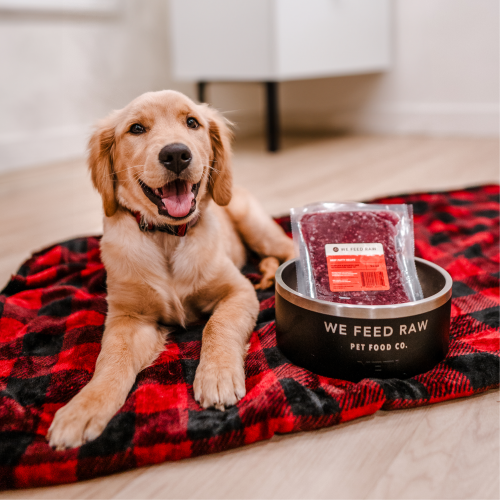
Start Your Puppy on the Right Paw With We Feed Raw
Feed your puppy the best species-appropriate diet you can: We Feed Raw. Our recipes are complete and balanced for dogs of all life stages, including the growth of large-breed puppies.
“Won’t raw food make my puppy sick?” Nope. We Feed Raw uses a cold-pressure process to inactivate potential pathogens, making our food safe for even the youngest (weaned) puppies.
Puppies on a raw diet have been shown to have fewer ear infections, skin allergies, and digestive problems than puppies fed kibble.
Give your puppy the best start in life. Take our quiz now to get matched with your puppy’s perfect meal plan.
Frequently Asked Questions (FAQs)
How long should it take to potty train a puppy?
Puppies can learn potty training basics in as little as a week, but due to their tiny bladders, most puppies aren’t fully potty trained and accident-free until at least 9 months of age.
How long to potty train a puppy?
It can take as little as a week to teach your puppy the basics of potty training. However, their small bladders make puppies prone to accidents until they reach at least 9 months of age.
How to easily potty train a puppy?
To easily potty train a puppy, create a routine where you take them outside every hour or so and after every meal, drink of water, nap, and playtime. Supervise or contain your puppy to help prevent accidents between trips outside.
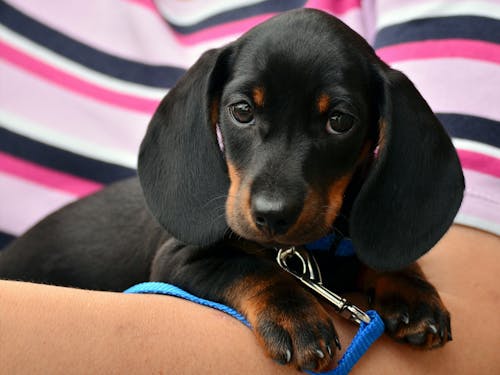
How to potty train a puppy fast?
To potty train a puppy fast, stick to a routine where you take them out regularly. Puppies need to pee about every hour per month of their age, so a two-month-old puppy needs to pee at least every two hours. Reward your puppy when they do their business outside and confine them to a small space when you can’t watch them to help prevent accidents.
How to potty train a puppy quickly?
To potty train a puppy quickly, you need to take your puppy out every hour or two so they can go potty outside before their bladder gets too full. Reward your puppy immediately for doing their business outside, and limit their opportunities to wander around your home and go potty where they shouldn’t.
How to train a puppy to potty?
To train a puppy to potty, take them out consistently, at least every hour or two, and supervise or contain your puppy in between potty breaks. Reward your puppy for peeing and pooping outside and do your best to prevent them from doing their business inside.
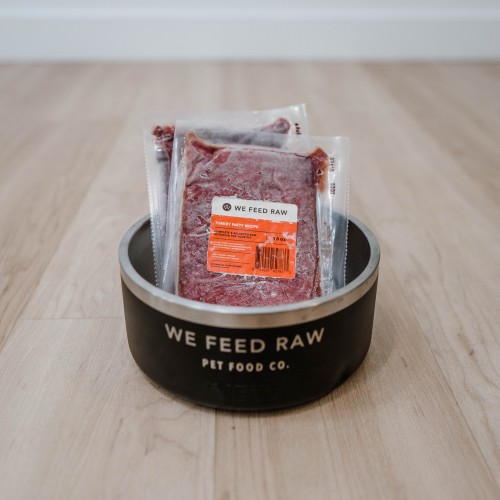
Help Your Puppy Thrive With We Feed Raw
Ready to help your puppy thrive on every level, including mastering the art of potty training? We Feed Raw provides a species-appropriate diet that serves as the perfect complement to your puppy's training routine. Our meticulously crafted recipes are balanced for all life stages, ensuring that your growing pup receives the nutrition they need for healthy development, which can also aid in a smoother and more efficient potty training process.
The benefits of a raw diet are evident, from reducing the likelihood of ear infections and skin allergies to mitigating digestive problems. What's more, our cold-pressure process ensures that our meals are safe from potential pathogens, providing peace of mind for you and a delightful feast for your furry friend.
By fueling your pup with We Feed Raw meals, you're not only setting the stage for successful potty training by maintaining a regular feeding schedule, but you're also contributing to their overall well-being and vitality. What could be better than a healthy puppy learning faster and more effectively?
Take the first step in tailoring the ideal meal plan for your puppy by taking our quiz. Join the We Feed Raw family and watch your pup flourish in health and behavior. Discover the power of raw feeding—visit wefeedraw.com now to get started.
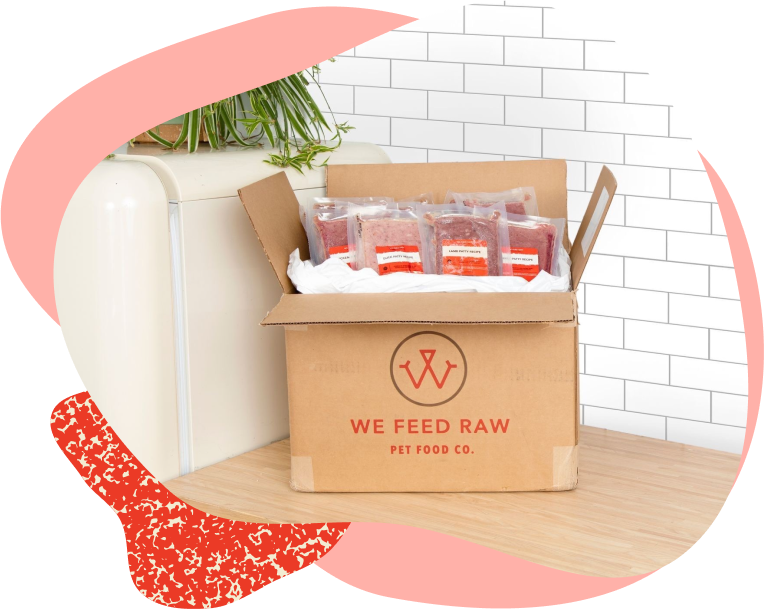
Complete & balanced raw meals.
Portioned out, packaged up, and cold-shipped (for FREE!).